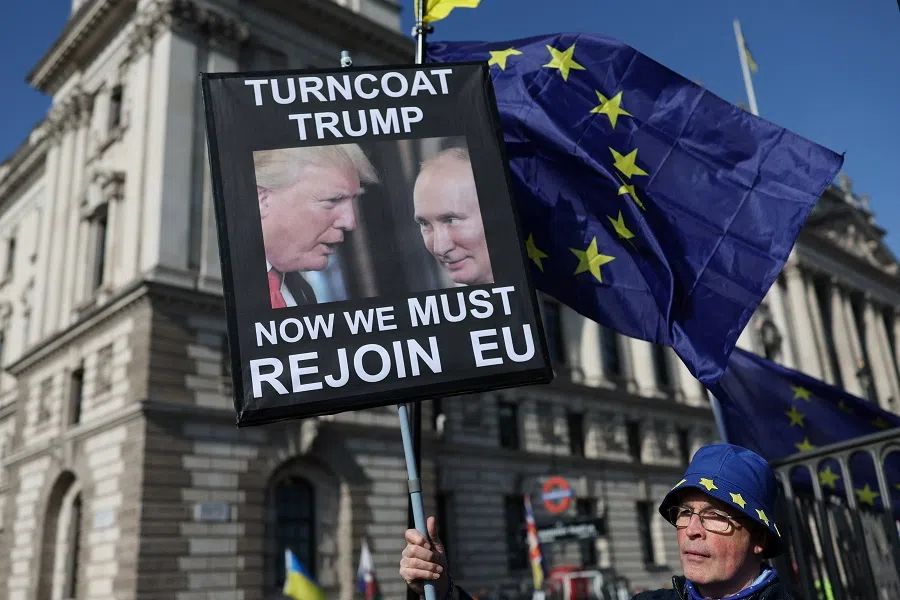Weaken and control: The US strategy for Eurasia and China
The US is not simply pro-Russia or pro-Ukraine; its actions aim to weaken both Russia and Europe, solidifying US control over Eurasia. This strategy of offshore balancing, also applied to China in the Indo-Pacific, reveals a broader geopolitical game. Chinese academic Han Heyuan explains.

Since taking office, US President Donald Trump has dramatically shifted his stance on Ukraine, drawing significant international attention. The reasoning behind this shift raises questions: is the US leaning “pro-Russia” or “pro-Ukraine”?
In my view, the strategic considerations extend beyond such binaries and are rooted in maintaining global hegemony. The US aims to control Europe by balancing the perceived threat between Russia and Europe. This strategy isn’t driven by conspiracy theories or masked by idealistic slogans; it’s a calculated choice based on geopolitical strategy and realist interests.
Preventing a dominant power in Eurasia
British geopolitical scientist Halford Mackinder first proposed the concept of Heartland in his 1904 paper “The Geographical Pivot of History”. He believed that Eastern Europe and Central Asia were the Pivot Area or Heartland of the “World Island”, and asserted that “whoever rules Eastern Europe controls the Heartland; whoever rules the Heartland controls the World Island; whoever rules the World Island controls the World”. As a Briton, Mackinder was worried that if a land-power nation (his concern then was Tsarist Russia) consolidated the resources of Euro-Asia, it might challenge the global hegemony of sea-power nations like Britain.
Preventing the emergence of a single dominant power on the Eurasian continent has always been the strategic core of Anglo-Saxon maritime powers. Having inherited this tradition, the US has demonstrated this behavioural pattern in the Russia-Ukraine war.
Against this backdrop, the US urgently needs an enemy like Russia — one that is “just right”.
During the Cold War, the US balanced the Soviet Union through NATO while integrating Western Europe into its own system via the Marshall Plan — not only preventing Soviet expansion but also suppressing the European Defence Community (EDC) initiative led by France and Germany.
After the Soviet Union collapsed in 1991, NATO’s five rounds of eastward expansion served the dual purpose of squeezing Russia’s strategic space to the east, while ensuring Central and Eastern European countries’ dependence on the US to the west.
Against this backdrop, the US urgently needs an enemy like Russia — one that is “just right”. From the US perspective, a “qualified threat” must meet two criteria: first, it must lack the strength to challenge American hegemony; second, it must be threatening enough to force Europe to seek US protection.
This strategy is reminiscent of the ancient Chinese warlords’ tactic of “raising bandits to bolster their own power” — or strategic containment — using a controlled threat as leverage to justify a long-term presence and influence in Europe.

This also means that an overly weakened Russia would not align with US interests. If Russia, as an external threat, ceases to exist, the legal rationale for a US-led NATO would collapse, and the justification for America’s continued presence in Europe would be lost. Likewise, if Europe and Russia were to reconcile, the US would lose a crucial lever for intervening in continental European affairs.
The US goal isn’t Ukraine’s victory
This explains the contradictions in US policy toward Russia. On the one hand, the US has provided Ukraine with tens of billions of dollars in military aid; on the other hand, it is deliberately delaying approval of F-16 fighter jets and long-range missiles, carefully controlling the pace of escalation.
The goal of the US has never been to help Ukraine achieve victory, but rather to turn the war into a grinding machine that depletes both Russia and Europe. In other words, US strategic decisions are never a simplistic choice between being “pro-Russia” or “pro-Ukraine”, but rather a complex balancing act driven by multiple interests.
The first objective is to weaken Russia’s war potential, stripping it of the capability to challenge US hegemony. This is achieved through a war of attrition that cripples the modernisation of the Russian military while using energy sanctions to undermine its economic resilience.
However, the US has consistently avoided a decapitation-style strike against the Russian leadership, fearing that excessively weakening Russia could disrupt the geopolitical balance and ultimately erode its control over Europe. This also explains why the Biden administration, despite maintaining long-term sanctions against Russia, has tacitly allowed countries like India and Turkey to continue transit trade with Moscow. The goal is simple: to prevent Russia’s economy from collapsing entirely.
Delaying European strategic autonomy
Secondly, the US aims to delay Europe’s strategic autonomy. Initiatives such as the plan for an “European army” led by France and Germany, and the EU’s European Defence Fund directly challenge the rationale for NATO’s existence. However, the Russia-Ukraine war has forced European countries to increase their defence spending to over 2% of GDP, with more than 60% of those funds being used to purchase American-made weapons — ironically deepening their dependence on the US.
If the Russia-Ukraine war were to be resolved through a European-led diplomatic initiative, the US would face a significant challenge to its dominance in Europe’s security architecture.
The US has also leveraged the Inflation Reduction Act to attract European industries, further weakening Europe’s economic independence. For the US, a strong and self-sufficient Europe is just as unacceptable as a resurgent Russia. Trump has even claimed that the EU was “formed to screw the US”.

The current push for European strategic autonomy — such as the EU’s Common Security and Defence Policy and the European army advocated by France and Germany — could indeed reduce NATO’s influence. If the Russia-Ukraine war were to be resolved through a European-led diplomatic initiative, the US would face a significant challenge to its dominance in Europe’s security architecture.
Lastly, the war has facilitated the restructuring of global supply chains, with the US emerging as the biggest winner from the resulting energy crisis. In 2022, EU imports of American liquefied natural gas (LNG) surged by 154%, with prices three times higher than Russian pipeline gas. Meanwhile, the military-industrial complex seized the opportunity to expand its market share, with defence contractors like Raytheon and Lockheed Martin seeing their stock prices soar by over 200%.
Weakening Russia and Europe
These objectives all serve a single core goal: to simultaneously weaken both Russia and Europe, thereby consolidating US control over the western edge of the Eurasian continent. For the US, a strong Russia is undesirable, and a strong Europe is equally unappealing.
What it seeks is offshore balancing — requiring Russia as a “qualified enemy” to help deter Europe, thereby providing the legal and moral justification for its presence in Europe. At the same time, it needs Europe, its so-called ally, to help constrain Russia, preventing any political entity from integrating Eurasian resources and forming a single dominant power capable of challenging US global hegemony.
The same logic applies in the Indo-Pacific region, where China faces similar treatment. The US will not tolerate China becoming too powerful, to the point of posing a threat to its hegemony. Similarly, it will not allow China’s strength to be excessively weakened, to the point where even Japan and South Korea would feel that the US military should withdraw from Okinawa. If this were to happen, the legitimacy and legal basis for the US’s continued presence in the Indo-Pacific would collapse.
This article was first published in Lianhe Zaobao as “美国在乌克兰问题上态度摇摆之谜”.





